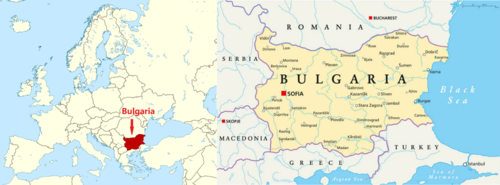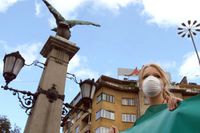Difference between revisions of "ISSS608 2018-19 T1 Assign Shen He"
Shenhe.2017 (talk | contribs) |
Shenhe.2017 (talk | contribs) |
||
| Line 1: | Line 1: | ||
<div style=background:#2B3856 border:#A3BFB1> | <div style=background:#2B3856 border:#A3BFB1> | ||
| − | [[Image: | + | [[Image:images.jpg|250px]] |
| − | <font size = 5; color="#FFFFFF"> | + | <font size = 5; color="#FFFFFF">Air quality in Sofia city</font> |
</div> | </div> | ||
<!--MAIN HEADER --> | <!--MAIN HEADER --> | ||
| Line 24: | Line 24: | ||
<br/> | <br/> | ||
| − | <font size= | + | =<font face="Book Antigua"; size=5>'''To be a Visual Detective'''</font>= |
Air pollution is an important risk factor for health in Europe and worldwide. A recent review of the global burden of disease showed that it is one of the top ten risk factors for health globally. Worldwide an estimated 7 million people died prematurely because of pollution; in the European Union (EU) 400,000 people suffer a premature death. The Organisation for Economic Cooperation and Development (OECD) predicts that in 2050 outdoor air pollution will be the top cause of environmentally related deaths worldwide. In addition, air pollution has also been classified as the leading environmental cause of cancer. | Air pollution is an important risk factor for health in Europe and worldwide. A recent review of the global burden of disease showed that it is one of the top ten risk factors for health globally. Worldwide an estimated 7 million people died prematurely because of pollution; in the European Union (EU) 400,000 people suffer a premature death. The Organisation for Economic Cooperation and Development (OECD) predicts that in 2050 outdoor air pollution will be the top cause of environmentally related deaths worldwide. In addition, air pollution has also been classified as the leading environmental cause of cancer. | ||
| Line 33: | Line 33: | ||
According to the WHO, 60 percent of the urban population in Bulgaria is exposed to dangerous (unhealthy) levels of particulate matter (PM10). | According to the WHO, 60 percent of the urban population in Bulgaria is exposed to dangerous (unhealthy) levels of particulate matter (PM10). | ||
| + | |||
| + | |||
| + | =<font face="Book Antigua"; size=5>'''What's Happening in Bulgaria '''</font>= | ||
| + | [[File:Homepage 001.png|500px|right]] | ||
| + | [[File:Homepage 002.jpeg|200px|right]] | ||
| + | <font face="Modern", size=2> | ||
| + | Air pollution is an important risk factor of health in Europe and worldwide, as there is convincing evidence that the primary air pollutant PM10 and PM2.5, regardless of source, have detrimental health effects. The most important anthropogenic sources of PM in ambient air in Europe are exhaust and non-exhaust emissions from road traffic and combustion of solid biomass. | ||
| + | <br> | ||
| + | <br> | ||
| + | Bulgaria, among European countries, is said to have the dirtiest air, with PM10 and PM2.5 overshooting EU limit. Urban populations in Bulgaria are exposed to the increasing risk of heart disease, lung cancer, respiratory diseases and stroke. | ||
| + | <br> | ||
| + | <br> | ||
| + | Bulgaria’s main sources of PM10, and fine particle pollution PM2.5 (particles 2.5 microns or smaller) are household burning of fossil fuels or biomass, and transport. Production of electricity by burning of coal in thermal power plants and other industrial processes are a major contributor to unhealthy air.</font> | ||
| + | <br> | ||
| + | <br> | ||
Revision as of 21:55, 17 November 2018
|
|
|
|
|
To be a Visual Detective
Air pollution is an important risk factor for health in Europe and worldwide. A recent review of the global burden of disease showed that it is one of the top ten risk factors for health globally. Worldwide an estimated 7 million people died prematurely because of pollution; in the European Union (EU) 400,000 people suffer a premature death. The Organisation for Economic Cooperation and Development (OECD) predicts that in 2050 outdoor air pollution will be the top cause of environmentally related deaths worldwide. In addition, air pollution has also been classified as the leading environmental cause of cancer.
Air quality in Bulgaria is a big concern: measurements show that citizens all over the country breathe in air that is considered harmful to health. For example, concentrations of PM2.5 and PM10 are much higher than what the EU and the World Health Organization (WHO) have set to protect health.
Bulgaria had the highest PM2.5 concentrations of all EU-28 member states in urban areas over a three-year average. For PM10, Bulgaria is also leading on the top polluted countries with 77 μg/m3on the daily mean concentration (EU limit value is 50 μg/m3).
According to the WHO, 60 percent of the urban population in Bulgaria is exposed to dangerous (unhealthy) levels of particulate matter (PM10).
What's Happening in Bulgaria
Air pollution is an important risk factor of health in Europe and worldwide, as there is convincing evidence that the primary air pollutant PM10 and PM2.5, regardless of source, have detrimental health effects. The most important anthropogenic sources of PM in ambient air in Europe are exhaust and non-exhaust emissions from road traffic and combustion of solid biomass.
Bulgaria, among European countries, is said to have the dirtiest air, with PM10 and PM2.5 overshooting EU limit. Urban populations in Bulgaria are exposed to the increasing risk of heart disease, lung cancer, respiratory diseases and stroke.
Bulgaria’s main sources of PM10, and fine particle pollution PM2.5 (particles 2.5 microns or smaller) are household burning of fossil fuels or biomass, and transport. Production of electricity by burning of coal in thermal power plants and other industrial processes are a major contributor to unhealthy air.


